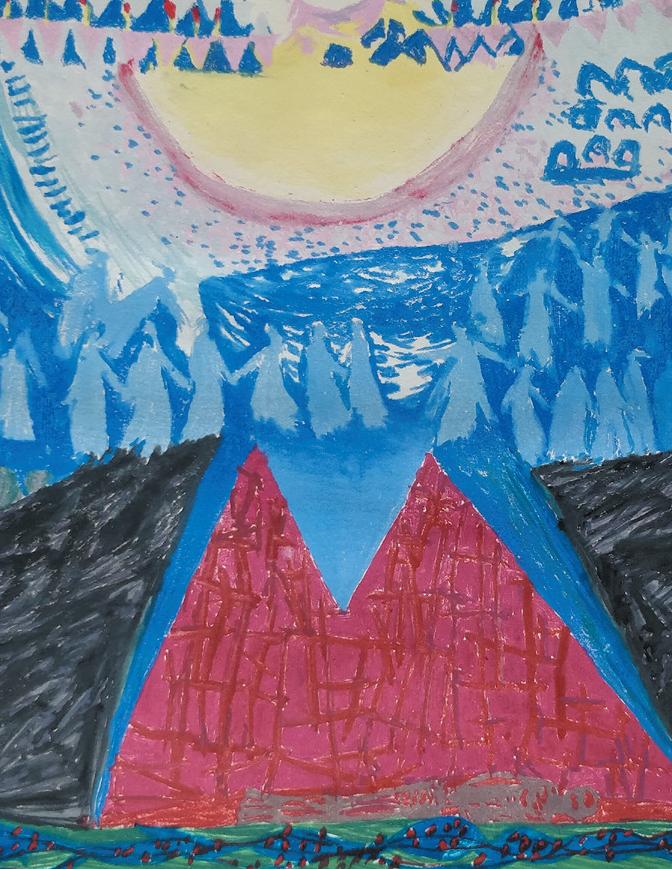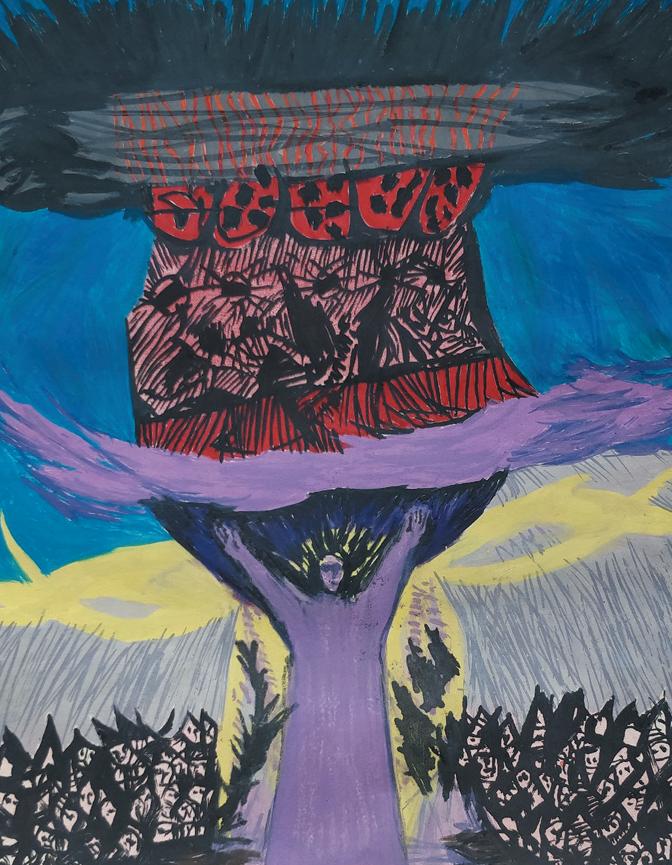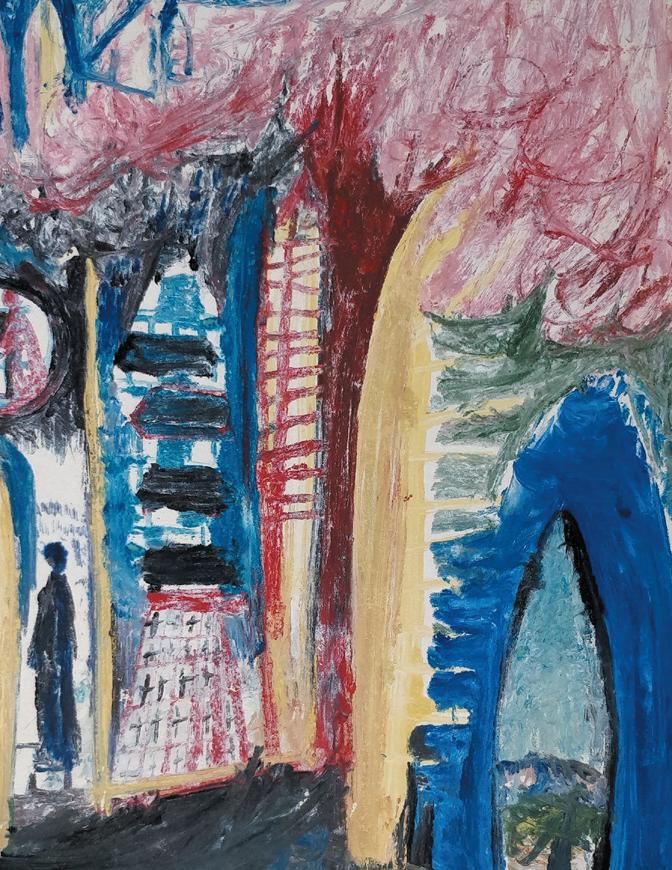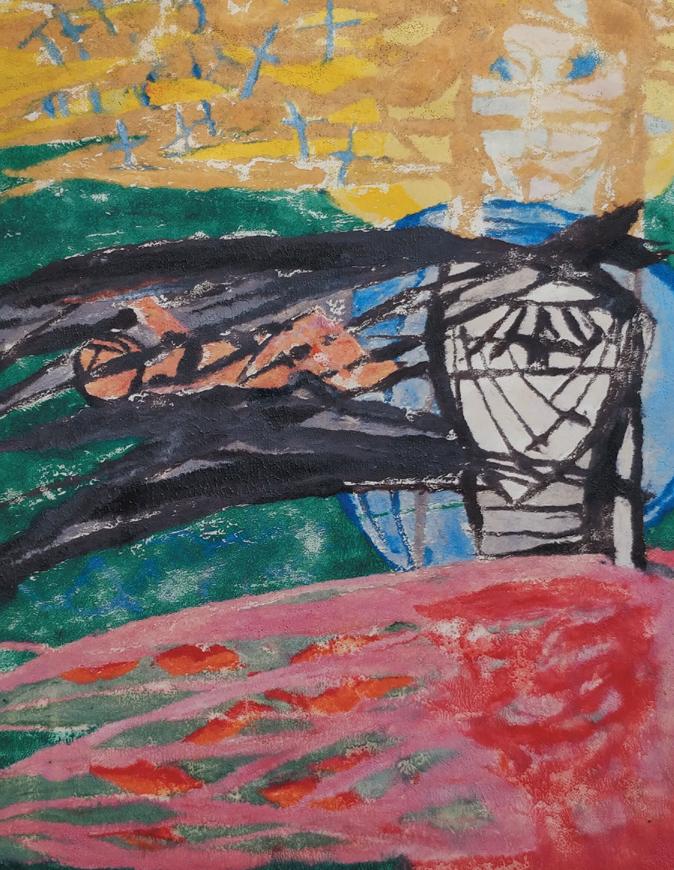











LIINA TALVIK


©Liina Talvik 2025 Collageofmonotypes:Hermann Talvik
Original title: HermannTalvik, Öppetsamtalmed Kristian Talvik
Translator:JaneDavis
Publisher: BoD–Books on Demand,Östermalmstorg1,114 42 Stockholm, Sweden,bod@bod.se
Printer: LibriPlureos GmbH,Friedensallee 273, 22763Hamburg
ISBN:978-91-8114-621-9

31 May1906–11 January1984
Onenight in thelate1930s,he wassuddenlyabletoconveyhis profound spiritualexperiencesthrough hisart.Inhis longingfor freedom, hisspiritual andartisticworld had merged,fertilising andenriching each other. Theexperiences took shape, flowinglike rhythms, shapes andsymbols over thepaper before himonthe floor. In this limitless dimensionhefeltasifhewerewithout skin.A spiritualvisuallanguageunfoldedlikean ethereal pilgrim’sway.Sometimes like fragilepoetry, at others with dramatic violence. He fell in love with themonotypeat an earlyage –withthistechnique that combinesthe unique possibilitiesof both painting andprintmaking.Withthe experiences of thenight stillfresh andalive as vibrations within him, he paintedona sheetofglass andmadea single print. Andsohecontinued,for severalnights, with severaldifferent artworks.Mostlyincolour, butevenatanearly stageofhis career as themasterofthe monotype, he also createdblack-and-white monotypes.
Theinteraction betweenblack andwhite wasaninstrumentfor hisartisticexpression.Asachild he mixedcharcoalfromthe stovewitha fewdrops of rainwater, painting with sensitive fingersinsilky grey shades andpowerfulcoal-blacklines.His love of printmakingwas born from this musicalexperience. He wouldchoosehis technique to suit thesubject:linocutsfor powerful fields balancingeachother;etchingsfor light, depthand saturatedchasms; drypointsgivingmicroscopic variations in line anddark places of concealment; andmonotypes andpaintings offeringcosmicenvironments bathed in colour.
Landscapes,his conversationswithnature, hadpreviouslybeenhis most common subject. Butlandscapestoo hadsouls –theywerenot merely depictions. They were sensitiveinterpretationofthe encounterbetween hisidentityasanartistand thesilent freedomoffered by nature,which gave himstrength. He felt freedomjustasstronglyin thecascadesof dazzling sunlight as in thescent of newly-fallen snow.
At theage of just thirteen,hewas accepted throughspecial dispensation by the TallinnState ArtSchool. At twenty-two,hemoved to Helsinki to studyatthe art school in theAteneum.Soonstudy tripsinEuropealsoinspiredand expanded his knowledge.
He hungered formore, andParis became hissecondhome. Butthe period of violent upheavalsinEuropewas to obstruct hisfreedom.Afflictedbysightsthatwould remain with himfor decades, andafter fleeingfor hislifetoavoid thefront,hewas forced to leavehis homeland.
In 1944 he arrivedinSweden. He sought outthe mountainswhere thecrystal clear airwas saturatedonlybysilence andwhere thecurrent moment wasnolongerathreat.
He didnot seek outthe companyofpeople. Aconstantdialoguewithnatureand proximitytoanastralworld were theonlycompanionship he required.Inpeoplehesaw thespiritasa light, andthatlight as part of God. Butheobservedwithsorrowthatthe individual rarely understood theirown spiritualwealthand competence,thatpeople lacked thetools to embark on theirown innerjourney,and that they were unawareof theirown role in agreater whole.
He hopedhis spiritualcompositionscould be thekey that opened emotionaldoors. In thesensitive observer’s eye, thegazecould be turned inwards. Inwardsfromthe proffered imageand into theindividual’sown spiritualpresence. Theaim of hiswork wasnot forthe viewer to gettoknow him better. Theaim wasfor us to gain agreater understandingof ourselves.
He hopedthathis artwould form an oasisfor meditation whereall experienceswere equallyvalid,where allpeoplehad thesamevalue andall languagesgainedthe same respect. Languagesbased on words, on rhythms, colour,shape or tones.
He knew that thelanguageof images is oneofunrestrictedinstantaneous communication,where theexperienceisbornfroma closerelationshipbetween thevisible and theinvisible,between theobjectand thevoid.
He knew that thewordcan causethe shimmerofexperiencetopaleand existential claritytodissolve.
He wanted us to approach hisart as we do music. In thesameway that we allowthe notes of musictoenfoldus, he wanted us to become seekersinhis work.
He wanted us to show each otherrespect in ourclumsyattemptstodescribeinwords thepaths we wander on foreignsoil– wordsdesignedtofunctioninthe concrete reality we find ourselvesin, this realitythatiscomprehensibleand viewable over time,where everything hasa startand everything hasanend.
“Whatdoyou see?”heasked. Often.
Thequestion wasdirectedatour innermost being. Because whatdowesee?What do yousee,and what do Isee?Who arewe? Do we truly knowwho we are? Youand I?
In this series, An open conversation with ..., Italk to people who,invariousways, have been affected by Hermann Talvik’s highly personal and sensitivecompositions.My hope is that,asa reader, youwillfeelinvited to mentally take partinthisconversation. That youwill permit yourself to reflect, question and accept your ownthoughts as well as my own–and ours. In this book,Imeet my brother Kristian foralong conversation about our father and hisart
Hermann Talvik (1906–1984)was aversatile artist, both in terms of techniquesand subject matter. His painting runs from lyrical landscapestospiritualcompositions.
His prints span the range from woodcuts andlinocuts to drypointsand etchings.He wasalso themasterofthe monotype –a techniqueinwhich asingle copyismadeof the paint on a flat surface.
Much of hisart has its origins in experiences from aworld beyond thephysical one. The compositions areloaded with acomplex symboliclanguage –sometimesthe depiction of aviolentevent,sometimes an encounter in dazzlinglight– while others illustrate Biblical stories.
He wasreluctanttotalk about hisown vision andwhatlay behind hisworks. He preferred not even to name hisartworks, as he felt this would get in the wayofour personal interpretations. Interpretationsthat canbe coloured by our unique experiencesand which arelinked to our ownspiritual presence
Whatdoyou see?
